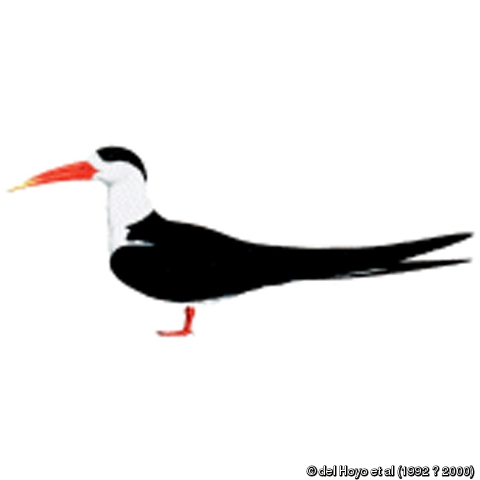| Citation |
|
Description |
Geographic Range [top]
Range Description: Rynchops albicollis is confined to Pakistan and India, north of c.16°N, Bangladesh, where a large proportion of the population winters, principally in the Padma-Meghna delta, and Myanmar. It is a rare visitor to Nepal. It was formerly widely distributed across the Indian Subcontinent, along the major rivers of Myanmar and along the Mekong in Indo-China. It was common in the 19th century in Myanmar, Laos, Cambodia and Vietnam, but there are very few recent records from Myanmar (Sundar 2004) and none from Laos, Cambodia or Vietnam. It has declined in India and Pakistan. Its population is estimated at 6,000-10,000 mature individuals.
Countries occurrence:
Native:
Bangladesh; India; Myanmar; Nepal; Pakistan; Viet Nam
Possibly extinct:
Cambodia
Regionally extinct:
China; Lao Peoples Democratic Republic
Vagrant:
Iran, Islamic Republic of; Oman; Thailand
Additional data:
? Continuing decline in area of occupancy (AOO): Yes
? Extreme fluctuations in area of occupancy (AOO): No ? Estimated extent of occurrence (EOO) - km2: 5030000
? Continuing decline in extent of occurrence (EOO): Yes ? Extreme fluctuations in extent of occurrence (EOO): No
? Number of Locations: 11-100 ? Continuing decline in number of locations: Yes
? Extreme fluctuations in the number of locations: No
Range Map: Click here to open the map viewer and explore range.
Population [top]
Population: The population was estimated to number 10,000 individuals by Perennou et al. (1994), but BirdLife International (2001) considered that it may well have fallen below this level given the evidence of declines throughout its range. The Asian Waterbird Census recorded 5,542 in 2001 (Li and Mundkur 2004). S. Balachandran (in litt. 2005) estimated the Indian population to be 2,500 individuals. Its total poulation is estimated at 6,000-10,000 individuals, roughly equating to 4,000-6,700 mature individuals.
Trend Justification: Rapid population declines are suspected to be occurring, in line with the widespread degradation of riverine and wetland habitats throughout the speciess range.
Current Population Trend: Decreasing
Additional data:
? Number of mature individuals: 4000-6700 ? Continuing decline of mature individuals: Yes
? Extreme fluctuations: No ? Population severely fragmented: No
? No. of subpopulations: 2-100 ? Continuing decline in subpopulations: Yes
? Extreme fluctuations in subpopulations: No ? All individuals in one subpopulation: No
? No. of individuals in largest subpopulation: 1-89
Habitat and Ecology [top]
Habitat and Ecology: It occurs primarily on larger, sandy, lowland rivers, around lakes and adjacent marshes and, in the non-breeding season, estuaries and coasts. It breeds colonially on large, exposed sand-bars and islands.
Systems: Terrestrial; Freshwater
Continuing decline in area, extent and/or quality of habitat: Yes
Generation Length (years): 11.5
Movement patterns: Full Migrant
Congregatory: Congregatory (and dispersive)
Threats [top]
Major Threat(s): Its decline is attributable to widespread increases in human disturbance, exploitation and degradation of rivers and lakes through fishing, transportation, domestic use, irrigation schemes and pollution from agricultural and industrial chemicals. These factors have reduced reproductive and foraging success. The population stronghold at National Chambal Sanctuary, Utter Pradesh (India) has been badly affected by the damming of the Chambal River in upstream Rajastan, resulting in dropping water levels and allowing predators and livestock to access breeding islands (Sundar 2004). Water release from dams and seasonal floods can destroy breeding colonies. Encroachment of vegetation, especially the invasive water hyacinth Eichhornia crassipes, is an increasing problem at lakes and reservoirs. House Crows Corvus splendens, which have been witnessed to decimate at least one breeding colony, are attracted to human settlements, cultivation and areas of food waste and animal carcass disposal, activities that also encourage the presence of stray and domestic dogs (Siddiqui et al. 2007).
Conservation Actions [top]
Conservation Actions: Conservation Actions Underway
It occurs in National Chambal Sanctuary, India. Narora, in Uttar Pradesh, has been declared a Ramsar site (Siddiqui et al. 2007). Active management has reduced key threats at some wetland sites.
Conservation Actions Proposed
Conduct surveys in Myanmar, Bangladesh and Cambodia to clarify its current distribution and status. Organise a population census in India and Pakistan during the breeding season. Conduct detailed research into seasonal movements of non-resident populations. Campaign for strict protection of the National Chambal Sanctuary, with particular reference to the maintenance of high water levels during the breeding season. Promote active management of static wetlands used as feeding areas. Promote strict control of pesticide use near important sites. Research and mitigate threats at important breeding colonies. Campaign for increased representation of large waterways in protected-area systems. Carry out awareness-raising activities (Siddiqui et al. 2007), perhaps targeting certain stretches of river. Consider persuading some farmers to abandon islands along certain stretches of river (Siddiqui et al. 2007). In some areas, use physical barriers and people to prevent access to river islands by other people and unwanted animals (Siddiqui et al. 2007).
Citation: BirdLife International. 2016. Rynchops albicollis. The IUCN Red List of Threatened Species 2016: e.T22694268A93444131. Downloaded on 14 December 2016.
Disclaimer: To make use of this information, please check the .
Feedback: If you see any errors or have any questions or suggestions on what is shown on this page, please provide us with feedback so that we can correct or extend the information provided |


